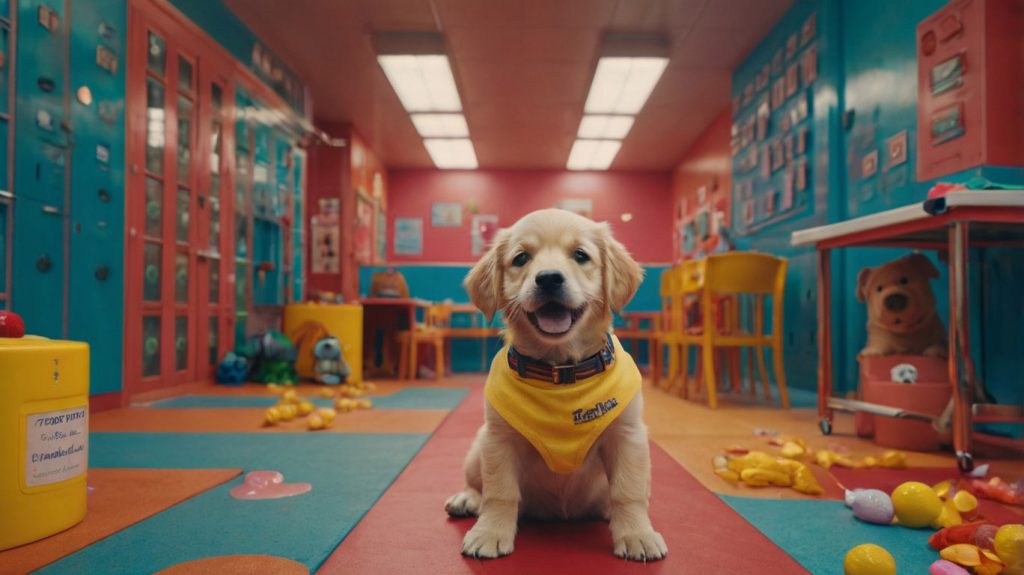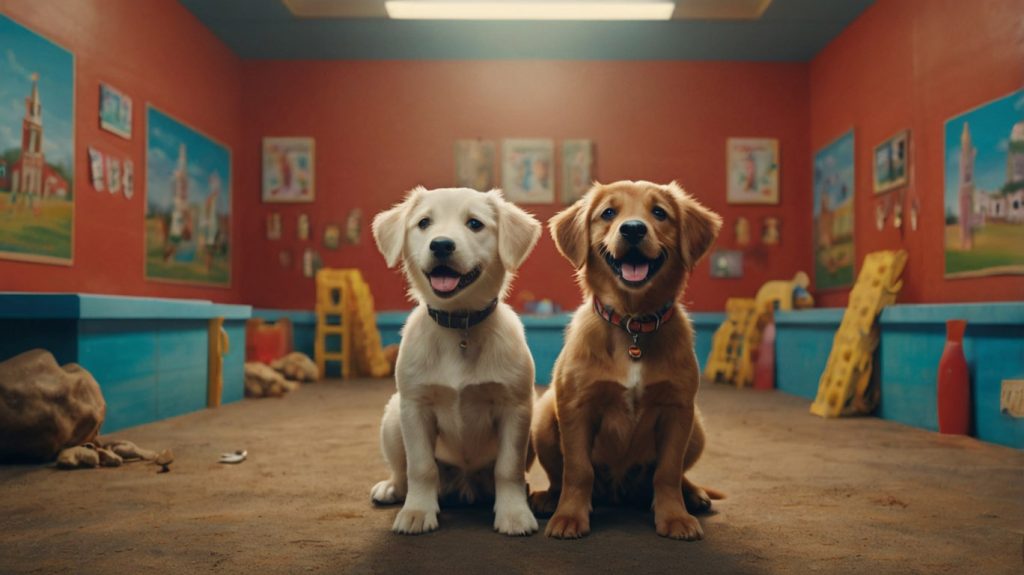Canine Kindergarten
Imagine a place where your energetic, curious, and sometimes mischievous puppy is welcomed with open paws and wagging tails. That’s the heart of canine kindergarten —a structured, fun-filled environment designed to nurture your pup’s early development in ways that go far beyond sit and stay.
What is Canine Kindergarten?
Canine kindergarten, sometimes called puppy preschool, is a socialization and training program for young puppies, typically between 8 to 20 weeks of age. It blends gentle training, exposure to various stimuli, and positive reinforcement to build essential life skills.
The goal is to create a confident, well-mannered dog by laying a foundation of trust, safety, and structure. Think of it as a prep school for puppies—before the real challenges of the world begin.

The Importance of Canine Kindergarten
Early socialization is not just recommended—it’s critical. A puppy’s brain is like a sponge during their formative weeks. What they learn, or don’t learn, during this period stays with them for life. Enrolling your pup in canine kindergarten during this “golden window” can reduce fear, anxiety, and future behavioral issues.
Moreover, it promotes healthy interaction with other dogs and people, reducing the chances of aggression or overexcitement later in life.
Canine Kindergarten vs Dog Training Classes
While both serve vital roles in dog development, canine kindergarten is for the very young. The focus here is on socialization, basic manners, and gentle handling. Traditional dog training classes, on the other hand, usually start after 5 months and focus more on obedience, commands, and discipline.
If your puppy is still teething, a little clumsy, or scared of vacuum cleaners—kindergarten is the place to start.
Benefits of Canine Kindergarten
The benefits are many—and they go beyond the surface:
- Social Development: Learn to play politely and handle conflict
- Confidence Building: Exposure to sights, sounds, and other animals
- Basic Commands: Sit, down, come, leave-it, and more
- Reduced Separation Anxiety: Familiarity with different people and settings
- Owner Education: Learn how to reinforce behaviors at home
These aren’t just convenient; they’re game-changers.
How Puppies Learn Through Play in Canine Kindergarten
Puppy play isn’t random—it’s purposeful. Trainers supervise and encourage positive interactions that teach impulse control, bite inhibition, and cooperation. Through supervised play, pups learn what’s acceptable and what’s not, all while burning off their boundless energy.
When your puppy “play-bows” and takes turns in a tug-of-war game, they’re learning life lessons.

Understanding Puppy Behavior in Kindergarten Settings
At first, puppies might bark excessively, shy away, or act out. That’s normal! Trained staff gently guide them toward better behavior by interpreting their signals. A tucked tail may signal fear, while jumping could mean excitement. Each behavior is a clue to help shape a well-rounded dog.
Canine Kindergarten Builds Confidence in Shy Puppies
Shy puppies bloom in the right environment. Repeated exposure to new dogs, friendly strangers, and interesting toys helps shy pups become brave adventurers. Trainers use desensitization techniques to make them more comfortable with the unfamiliar.
Socialization : The Core of Canine Kindergarten
Puppies meet dogs of different sizes, breeds, and energy levels. This teaches them to adapt their play style and respect boundaries. Learning how to “read the room” socially is as vital for dogs as it is for kids.
Trained Staff : Who’s Behind the Canine Kindergarten Magic?
The magic lies in the people. Certified dog trainers and behaviorists lead each class. They’ve seen it all—from over-eager retrievers to bashful bulldogs. These professionals offer tailored support and ensure every puppy feels safe and valued.
Top Skills Puppies Master in Canine Kindergarten
From leash manners to bathroom routines, here’s what’s on the curriculum:
- Basic commands: Sit, stay, come
- Crate comfort
- Name recognition
- Calm greetings
- Tolerance to touch (for vet visits)
All these create the building blocks of a polite pooch.
How to Choose the Right Canine Kindergarten
Not all puppy programs are created equal. When selecting a kindergarten for your pup, consider these factors:
- Cleanliness & Safety: Look for clean play areas and secure fencing.
- Class Size: Smaller classes allow for more personalized attention.
- Trainer Qualifications: Are staff members certified in canine behavior?
- Training Methods: Positive reinforcement should be the core philosophy.
- Puppy Age & Vaccination Requirements: Ensures safety for all attendees.
- Parental Involvement: Programs that include owner education are a huge plus.
It’s worth visiting a class before enrolling. Observe, ask questions, and trust your instincts.
What to Expect in a First Canine Kindergarten Class
The first class is like your puppy’s first day at school. Expect a mix of:
- Puppy introductions and monitored play
- Short obedience exercises
- Discussions on puppy behavior
- Tips for reinforcing learning at home
There may be some barking, sniffing, and even nervous accidents—but by the end, tails are wagging and friendships are forming.
Essential Vaccinations Before Enrolling in Canine Kindergarten
Before your puppy joins a group setting, they must have:
- First round of DHPP vaccine (Distemper, Hepatitis, Parvovirus, Parainfluenza)
- Bordetella (Kennel Cough)
- Rabies, depending on age and local regulations
Health checks protect everyone and prevent outbreaks. Most programs ask for veterinary records before enrollment.
Canine Kindergarten for Rescue Puppies
Rescue puppies often need extra time and TLC. Canine kindergarten offers them:
- Gentle exposure to normal life
- Structured interaction to rebuild trust
- Encouragement in a controlled setting
These experiences can erase trauma and create a foundation for a joyful life with their new family.
Signs Your Puppy is Ready for Canine Kindergarten
Wondering if your furball is ready? Look for signs like:
- Completed first round of vaccines
- Comfortable with handling
- Curiosity about other dogs
- Basic name recognition
If your puppy is fearful or reactive, don’t worry. A good trainer can assess and gently introduce them at their own pace.
How Canine Kindergarten Prevents Future Behavioral Issues
Many adult dog problems begin with a lack of socialization. Canine kindergarten addresses common future issues, such as:
- Aggression or fear toward strangers
- Separation anxiety
- Leash reactivity
- Excessive barking or destructive behavior
By catching these early, kindergarten helps raise balanced, happy dogs.
Stories from Real Puppy Parents : Canine Kindergarten Works
Let’s hear from a few pet parents:
“My husky Luna was terrified of people. After three weeks in canine kindergarten, she now greets neighbors with a wagging tail!” – Sarah, CO
“I didn’t believe structured puppy school would matter. But Max went from biting my slippers to sitting politely. Total transformation.” – James, TX
Real experiences show that structured early training truly makes a difference.
The Role of Positive Reinforcement in Canine Kindergarten
Yelling and punishment have no place here. Instead, trainers use:
- Treats
- Praise
- Clickers
- Play rewards
This creates trust and boosts learning. Puppies become eager to please, knowing good behavior brings good things.
Understanding Puppy Body Language
Canine kindergarten trainers pay close attention to:
- Tail position (confident vs. scared)
- Ear movement (alert vs. relaxed)
- Yawning or lip-licking (stress signals)
This helps trainers intervene before a situation escalates, promoting safe play.
Canine Kindergarten and Crate Training Go Hand in Paw
Most kindergartens introduce crate training. Puppies learn that crates are:
- Safe, quiet spaces
- Not punishments
- Great for naps and breaks
This is incredibly helpful at home when you need a moment of peace.
Building Puppy Routines Through Kindergarten
Routines are comforting. Your pup will quickly understand:
- Morning = playtime
- After potty = treat
- Trainer = fun + learning
This makes transitions at home smoother and reduces anxiety.
Nutrition Tips While Attending Canine Kindergarten
Puppies are growing fast and need good fuel. Tips include:
- Feed before class (but not right before!)
- Bring small training treats
- Keep fresh water available
Some programs even offer nutrition workshops for owners.
How Long Should Puppies Attend Canine Kindergarten?
Most programs last 4–8 weeks, meeting once or twice a week. Some offer ongoing social play after initial training, especially for high-energy breeds.
The right length depends on your puppy’s progress and needs.
What Happens After Canine Kindergarten?
Kindergarten is just the beginning. Afterward, you can explore:
- Basic obedience classes
- Agility training
- Therapy dog prep
- Nose work
Your pup now has a foundation to build on. Keep the momentum going!
Canine Kindergarten for Different Breeds
Not all dogs learn the same way. Programs often adapt based on breed:
- Working breeds (German Shepherds, Labs): Need structure + mental stimulation
- Toy breeds (Chihuahuas, Yorkies): Need gentler introductions
- Guarding breeds (Rottweilers, Mastiffs): Need early exposure to prevent reactivity
Good programs recognize and celebrate these differences.
Indoor vs Outdoor Canine Kindergarten Setups
Indoor spaces are great for:
- All-weather learning
- Controlled noise and scent
- Cleaner environments
Outdoor programs offer:
- Natural distractions
- Real-world settings
- Bigger space to run and play
Many top programs blend both environments.
Canine Kindergarten and Your Family
Involving your whole family ensures consistency. Children can learn:
- How to greet dogs safely
- How to reinforce commands
- How to respect a puppy’s space
This is great bonding time and teaches responsibility.
The Cost of Canine Kindergarten
Prices vary based on location and amenities. Expect:
- Group classes: $150–$350 for 4–6 weeks
- Private sessions: $50–$100/hour
- Premium programs (with daycare): $500+
It’s an investment—but one that saves money (and sanity) in the long run.
Online Puppy Training vs In-Person Canine Kindergarten
Online programs exploded during the pandemic. While convenient, they lack:
- Real socialization
- Trainer supervision
- Controlled dog-to-dog interaction
Online courses are great supplements—but not replacements.
Tips for Making the Most of Canine Kindergarten
To maximize results:
- Practice at home daily
- Use the same commands the trainer uses
- Arrive early so your pup can settle
- Be patient—progress isn’t linear
- Stay positive and engaged
Your energy affects your puppy. If you’re confident and calm, they will be too.
FAQs
What age should a puppy start canine kindergarten?
Most puppies start around 8–12 weeks, after getting their first set of vaccinations.
Is canine kindergarten worth the money?
Absolutely. The long-term behavioral benefits far outweigh the cost.
Can older dogs join canine kindergarten?
Kindergarten is for puppies. Older dogs benefit from basic or advanced obedience classes instead.
How long is each class?
Typically 45–60 minutes, to match a puppy’s short attention span.
What should I bring to class?
Bring treats, poop bags, a leash, vaccination proof, and your pup’s favorite toy.
Can aggressive puppies attend?
Mild behavioral issues are addressed gently. Truly aggressive puppies may need a behaviorist before group classes.
Conclusion : Canine Kindergarten Sets the Stage for a Lifetime of Good Behavior
Canine kindergarten is more than just puppy playtime—it’s a smart, compassionate way to shape your dog’s future. Through guided socialization, training, and care, it provides your pup with the skills and confidence to thrive in a busy world. The earlier you start, the better the outcome.
From taming chaos to building calm, the kindergarten experience is a gift to both dogs and their humans. Ready to give your pup the best start possible? Find a local program and watch your little one blossom.

